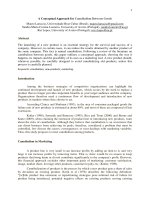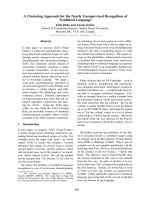Applied Biophysics A Molecular Approach for Physical Scientis pdf
Bạn đang xem bản rút gọn của tài liệu. Xem và tải ngay bản đầy đủ của tài liệu tại đây (9.87 MB, 436 trang )
Applied Biophysics
Applied Biophysics
A Molecular Approach for
Physical Scientists
Tom A. Waigh
University of Manchester, Manchester, UK
John Wiley & Sons, Ltd
Copyright ß 2007 John Wiley & Sons Ltd, The Atrium, Southern Gate, Chichester,
West Sussex PO19 8SQ, England
Telephone (þ44) 1243 779777
Email (for orders and customer service enquiries):
Visit our Hom e Page on www.wiley europe.com or www. wiley.com
All Rights Reserved. No part of this publication may be reproduced, stored in a retrieval system or
transmitted in any form or by any means, electronic, mechanical, photocopying, recording, scanning or
otherwise, except under the terms of the Copyright, Designs and Patents Act 1988 or under the terms of a
licence issued by the Copyright Licensing Agency Ltd, 90 Tottenham Court Road, London W1T 4LP, UK,
without the permission in writing of the Publisher. Requests to the Publisher should be addressed to the
Permissions Department, John Wiley & Sons Ltd, The Atrium, Southern Gate, Chichester, West Sussex PO19
8SQ, England, or emailed to , or faxed to (þ44) 1243 770620.
Designations used by companies to distinguish their products are often claimed as trademarks. All brand
names and product names used in this book are trade names, service marks, trademarks or registered
trademarks of their respective owners. The Publisher is not associated with any product or vendor
mentioned in this book.
This publication is designed to provide accurate and authoritative information in regard to the subject matter
covered. It is sold on the understanding that the Publisher is not engaged in rendering professional services. If
professional advice or other expert assistance is required, the services of a competent professional should be
sought.
The Publisher and the Author make no representations or warranties with respect to the accuracy or
completeness of the contents of this work and specifically disclaim all warranties, including without
limitation any implied warranties of fitness for a particular purpose. The advice and strategies contained
herein may not be suitable for every situation. In view of ongoing research, equipment modifications, changes
in governmental regulations, and the constant flow of information relating to the use of experimental
reagents, equipment, and devices, the reader is urged to review and evaluate the information provided in
the package insert or instructions for each chemical, piece of equipment, reagent, or device for, among other
things, any changes in the instructions or indication of usage and for added warnings and precautions. The
fact that an organization or Website is referred to in this work as a citation and/or a potential source of
further information does not mean that the author or the publisher endorses the information the organization
or Website may provide or recommendations it may make. Further, readers should be aware that Internet
Websites listed in this work may have changed or disappeared between when this work was written and when
it is read. No warranty may be created or extended by any promotional statements for this work. Neither the
Publisher nor the Author shall be liable for any damag es arising herefrom.
Other Wiley Editorial Offices
John Wiley & Sons Inc., 111 River Street, Hoboken, NJ 07030, USA
Jossey-Bass, 989 Market Street, San Francisco, CA 94103-1741, USA
Wiley-VCH Verlag GmbH, Boschstr. 12, D-69 469 Weinheim, Germany
John Wiley & Sons Australia Ltd, 42 McDougall Street, Milton, Queensland 4064, Australia
John Wiley & Sons (Asia) Pte Ltd, 2 Clementi Loop #02-01, Jin Xing Distripark, Singapore 129809
John Wiley & Sons Ltd, 6045 Freemont Blvd, Mississ auga, Ontario L5R 4J3, Canada
Wiley also publishes its books in a variety of electronic formats. Some content that appears in print may not
be available in electronic books.
Anniversary Logo Design: Richard J. Pacifico
Library of Congress Cataloging-in-Publication Data
Waigh, Tom A.
Applied biophysics : a molecular approach for physical scientists / Tom A. Waigh.
p. cm.
Includes index.
ISBN 978-0-470-01717-3 (alk. paper)
1. Biophysics. I. Title.
QH505.W35 2007
571.4–dc22 2007011017
British Library Cataloguing in Publication Data
A catalogue record for this book is available from the British Library
ISBN 9780470017173 Cloth, 9780470017180 Paper
Typeset in 10.5/13 Sabon by Thomson Digital, India
Printed and bound in Great Britain by TJ International Ltd, Padstow, Cornwall
This book is printed on acid-free paper responsibly manufactured from sustainable forestry
in which at least two trees are planted for each one used for paper production.
Contents
Preface xi
Acknowledgements xiii
1 The Building Blocks 1
1.1 Proteins 1
1.2 Lipids 11
1.3 Nucleic Acids 12
1.4 Carbohydrates 15
1.5 Water 18
1.6 Proteoglycans and Glycoproteins 20
1.7 Cells (Complex Constructs of Biomolecules) 21
1.8 Viruses (Complex Constructs of Biomolecules) 22
1.9 Bacteria (Complex Constructs of Biomolecules) 23
1.10 Other Molecules 23
Further Reading 23
Tutorial Questions 24
2 Mesoscopic Forces 25
2.1 Cohesive Forces 25
2.2 Hydrogen Bonding 28
2.3 Electrostatics 30
2.3.1 Unscreened Electrostatic Interactions 30
2.3.2 Screened Electrostatic Interactions 32
2.3.3 The Force Between Charged Spheres
in Solution 36
2.4 Steric and Fluctuation Forces 38
2.5 Depletion Forces 42
2.6 Hydrodynamic Interactions 44
2.7 Direct Experimental Measurements of Intermolecular
and Surface Forces 44
Further Reading 47
Tutorial Questions 48
3 Phase Transitions 49
3.1 The Basics 49
3.2 Helix–Coil Transition 53
3.3 Globule–Coil Transition 59
3.4 Crystallisation 64
3.5 Liquid–Liquid Demixing (Phase Separation) 68
Further Reading 74
Tutorial Questions 74
4 Liquid Crystallinity 77
4.1 The Basics 77
4.2 Liquid–Nematic–Smectic Transitions 92
4.3 Defects 95
4.4 More Exotic Possibilities for Liquid
Crystalline Phases 100
Further Reading 103
Tutorial Questions 104
5 Motility 107
5.1 Diffusion 108
5.2 Low Reynold’s Number Dynamics 116
5.3 Motility 119
5.4 First Passage Problem 121
5.5 Rate Theories of Chemical Reactions 125
Further Reading 127
Tutorial Questions 127
6 Aggregating Self-Assembly 129
6.1 Surfactants 133
6.2 Viruses 137
6.3 Self-Assembly of Proteins 139
6.4 Polymerisation of Cytoskeletal Filaments (Motility) 142
Further Reading 148
Tutorial Questions 149
7 Surface Phenomena 151
7.1 Surface Tension 151
7.2 Adhesion 154
7.3 Wetting 156
vi CONTENTS
7.4 Capillarity 160
7.5 Experimental Techniques 164
7.6 Friction 165
7.7 Other Surface Phenomena 168
Further Reading 168
Tutorial Question 169
8 Biomacromolecules 171
8.1 Flexibility of Macromolecules 171
8.2 Good/Bad Solvents and the Size of Polymers 177
8.3 Elasticity 183
8.4 Damped Motion of Soft Molecules 187
8.5 Dynamics of Polymer Chains 191
8.6 Topology of Polymer Chains – Super Coiling 199
Further Reading 201
Tutorial Questions 202
9 Charged Ions and Polymers 205
9.1 Electrostatics 207
9.2 Debye–Huckel Theory 213
9.3 Ionic Radius 214
9.4 The Behaviour of Polyelectrolytes 218
9.5 Donnan Equilibria 221
9.6 Titration Curves 223
9.7 Poisson–Boltzmann Theory for Cylindrical
Charge Distributions 227
9.8 Charge Condensation 228
9.9 Other Polyelectrolyte Phenomena 232
Further Reading 234
Tutorial Questions 235
10 Membranes 237
10.1 Undulations 238
10.2 Bending Resistance 240
10.3 Elasticity 243
10.4 Intermembrane Forces 248
Further Reading 250
Tutorial Questions 251
11 Continuum Mechanics 253
11.1 Structural Mechanics 254
CONTENTS vii
11.2 Composites 258
11.3 Foams 261
11.4 Fracture 263
11.5 Morphology 265
Further Reading 265
Tutorial Questions 266
12 Biorheology 267
12.1 Storage and Loss Moduli 270
12.2 Rheological Functions 274
12.3 Examples from Biology 276
12.3.1 Neutral Polymer Solutions 276
12.3.2 Polyelectrolytes 280
12.3.3 Gels 283
12.3.4 Colloids 287
12.3.5 Liquid Crystalline Polymers 288
12.3.6 Glassy Materials 290
12.3.7 Microfluidics in Channels 291
Further Reading 291
Tutorial Questions 291
13 Experimental Techniques 293
13.1 Static Scattering Techniques 294
13.2 Dynamic Scattering Techniques 297
13.3 Osmotic Pressure 303
13.4 Force Measurement 306
13.5 Electrophoresis 314
13.6 Sedimentation 321
13.7 Rheology 325
13.8 Tribology 333
13.9 Solid Properties 334
Further Reading 335
Tutorial Questions 336
14 Motors 339
14.1 Self-assembling Motility – Polymerisation of Actin
and Tubulin 341
14.2 Parallelised Linear Stepper Motors – Striated Muscle 346
14.3 Rotatory Motors 350
14.4 Ratchet Models 350
14.5 Other Systems 352
viii CONTENTS
Further Reading 353
Tutorial Question 353
15 Structural Biomaterials 355
15.1 Cartilage – Tough Shock Absorber in Human Joints 355
15.2 Spider Silk 368
15.3 Elastin and Resilin 369
15.4 Bone 371
15.5 Adhesive Proteins 372
15.6 Nacre and Mineral Composites 373
Further Reading 375
Tutorial Questions 375
16 Phase Behaviour of DNA 377
16.1 Chromatin – Naturally Packaged DNA Chains 377
16.2 DNA Compaction – An Example of Polyelectrolyte
Complexation 380
16.3 Facilitated Diffusion 383
Further Reading 387
Appendix 389
Answers to Tutorial Questions 391
Index 407
CONTENTS ix
Preface
The field of molecular biophysics is introduced in the following pages.
The presentation focuses on the simple underlying concepts and demon-
strates them using a series of up to date applications. It is hoped that the
approach will appeal to physical scientists who are confronted with
biological questions for the first time as they become involved in the
current biotechnological revolution.
The field of biochemistry is vast and it is not the aim of this textbook
to encompass the whole area. The book functions on a reductionist,
nuts and bolts approach to the subject matter. It aims to explain the
constructions and machinery of biological molecules very much as a
civil engineer would examine the construction of a building or a
mechanical engineer examine the dynamics of a turbine. Little or n o
recourse is taken to the chemical side of the subject, instead modern
physical ideas are introduced to explain aspects of the phenomena that
are confronted. These ideas provide an alternative, complementary set
of tools t o solve biophysical problems. It is thus hoped that the book
will equip the read er with these new too ls to approac h the subjec t o f
biological physics.
A few rudimentary aspects of medical molecular biophysics are con-
sidered. In terms of the statistics of the cause of death, heart disease,
cancer and Alzheimer’s are some of the biggest issues that confront
modern society. An introduction is made to the action of striated muscle
(heart disease), DNA delivery for gene therapy (cancers and genetic
diseases), and self-assembling protein aggregates (amyloid diseases
such as Alzheimer’s). These diseases are some of the major areas of
medical research, and combined with food (agrochemical) and pharma-
ceutics, provide the major industrial motivation encouraging the devel-
opment of molecular biophysics.
Please try to read some of the highlighted books, they will prove
invaluable to bridge the gap between undergraduate studies and active
areas of research science.
Tom Waigh
Manchester, UK
February 2007
xii PREFACE
Acknowledgements
I would like to thank my family (Roger, Sally, Cathy, Paul, Bronwyn and
Oliver) and friends for their help and support. The majority of the book
was written in the physics department of the Universities of Manchester
and Leeds. The PhD and undergraduate students (the umpa lumpas etc.)
who weathered the initial course and the rough drafts of the lecture notes
on which this book was based should be commended. I am indebted to
the staff at the University of Edinburgh, the University of Cambridge and
the Colle
`
ge de France who helped educate me concerning the behaviour
of soft condensed matter and molecular biophysics.
1
The Building Blocks
It is impossible to pack a complete biochemistry course into a single
introductory chapter. Some of the basic properties of the structure of
simple biological macromolecules, lipids and micro organisms are cov-
ered. The aim is to give a basic grounding in the rich variety of molecules
that life presents, and some respect for the extreme complexity of the
chemistry of biological molecules that operates in a wide range of cellular
processes.
1.1 PROTEINS
Polymers consist of a large number of sub-units (monomers) connected
together with covalent bonds. A protein is a special type of polymer. In a
protein there are up to twenty different amino acids (Figure 1.1) that can
function as monomers, and all the monomers are connected together
with identical peptide linkages (C–N bonds, Figure 1.2). The twenty
amino acids can be placed in different families dependent on the chem-
istry of their different side groups. Five of the amino acids form a group
with lipophilic (fat-liking) side-chains: glycine, alanine, valine, leucine,
and isoleucine. Proline is a unique circular amino acid that is given its
own separate classification. There are three amino acids with aromatic
side-chains: phenylalanine, tryptophan, and tyrosine. Sulfur is in the
side-chains of two amino acids: cysteine and methionine. Two amino
acids have hydroxyl (neutral) groups that make them water loving: serine
and threonine. Three amino acids have very polar positive side-chains:
lysine, arginine and histidine. Two amino acids form a family with acidic
Applied Biophysics: A Molecular Approach for Physical Scientists Tom A. Waigh
# 2007 John Wiley & Sons, Ltd
Aliphatic amino acids
C
H
COO-
H
H
3
N
+
C COO-
CH
3
H
3
N
+
H
C COO-H
3
N
+
H
CH
3
CH
3
Glycine Alanine Valine
C COO-
CH
2
H
H
3
N
+
CH
CH
3
CH
3
C COO-H
3
N
+
CH
2
CH
3
CH
2
CH
3
CH
3
Leucine Isoleucine
Amino acids with hydroxyl or sulfur containing groups
CH
2
OH
H
3
N
+
CH
3
C COO-
C COO-H
3
N
+
H
SH
CH
2
C COO-H
3
N
+
HCOH
H
CH
3
H
COO-H
3
N
+
CH
2
CH
2
S
CH
3
Serine Cysteine Threonine Methionine
Aromatic amino acids
C COO-
H
H
3
N
+
CH
2
C COO-
H
H
3
N
+
OH
CH
2
N
H
CH
2
CCOO-
H
H
3
N
+
Phen
y
lalanine T
y
rosine Tr
y
ptophan
Figure 1.1 The chemical structure of the twenty amino acids found in nature
2 THE BUILDING BLOCKS
Cyclic amino acid
C
CH
2
COO-
CH
3
H
2
N
CH
2
CH
2
Proline
Basic amino acids
HN
NH
CH
2
C
H
COO-H
3
N
+
C
CH
2
CH
2
CH
2
CH
2
NH
2
COO-
H
H
3
N
+
C
CH
2
CH
2
CH
2
NH
C
COO-
H
H
3
N
+
NH
2
NH
2
Histidine Lysine Arginine
Acidic amino acids and amides
COO-CH
3
N
+
CH
2
C
OO
H
C
CH
2
C
OO
C
H
COO-H
3
N
+
COO-CH
3
N
+
CH
2
C
NH
2
O
H
CH
2
CH
2
C
NH
2
O
C
H
COO-H
3
N
+
As
p
artic acid Glutamic acid As
p
ara
g
ine Glutamine
Figure 1.1 (Continued )
PROTEINS 3
side-groups and they are joined by two corresponding neutral counter-
parts that have a similar chemistry: aspartate, glutamate, asparagine, and
glutamine.
The linkages between amino acids all have the same chemistry and
basic geometry (Figure 1.2). The peptide linkage that connects all amino
acids together consists of a carbon atom attached to a nitrogen atom
through a single covalent bond. Although the chemistry of peptide
linkages is fairly simple, to relate the primary sequence of amino acids
to the resultant three dimensional structure in a protein is a daunting task
and predominantly remains an unsolved problem. To describe protein
structure in more detail it is useful to consider the motifs of secondary
structure that occur in their morphology. The motifs include alpha
helices, beta sheets and beta barrels (Figure 1.3). The full three dimen-
sional tertiary structure of a protein typically takes the form of a compact
globular morphology (the globular proteins) or a long extended confor-
mation (fibrous proteins, Figures 1.4 and 1.5). Globular morphologies
usually consist of a number of secondary motifs combined with more
disordered regions of peptide.
Charge interactions are very important in determining of the conforma-
tion of biological polymers. The degree of charge on a polyacid or polybase
(e.g. proteins, nucleic acids etc) is determined by the pH of a solution, i.e.
the concentration of hydrogen ions. Water has the ability to dissociate into
oppositely charged ions; this process depends on temperature
H
2
O @ H
þ
þ OH
À
ð1:1Þ
C
N
C
C
O
RH
C
O
N
H
C
H
ψ
φ
Figure 1.2 All amino acids have the same primitive structure and are connected with
the same peptide linkage through C–C–N bonds
(O, N, C, H indicate oxygen, nitrogen, carbon and hydrogen atoms respectively. R is a
pendant side-group whichprovides the amino acid with its identity, i.e. proline, glycine
etc.)
4 THE BUILDING BLOCKS
The product of the hydrogen and hydroxyl ion concentrations formed
from the dissociation of water is a constant at equilibrium and at a fixed
temperature (37
C)
c
H
þ
c
OH
À
¼ 1 Â 10
À14
M
2
¼ K
w
ð1:2Þ
where c
H
þ
and c
OH
À
are the concentrations of hydrogen and hydroxyl
ions respectively. Addition of acids and bases to a solution perturbs the
equilibrium dissociation process of water, and the acid/base equilibrium
Hydrogen
bond
O
C
O
N
H
C
O
H
N
C
N
C
H
H
O
N
C
N
N
C
O
N
O
C
H
O
N
C
O
C
N
H
C
N
N
H
O
(a)
Figure 1.3 Simplified secondary structures of (a) an a-helix and (b) a b-sheet that
commonly occur in proteins
(Hydrogen bonds are indicated by dotted lines.)
PROTEINS 5
phenomena involved are a corner stone of the physical chemistry
of solutions. Due to the vast range of possible hydrogen ion (H
þ
)
concentrations typically encountered in aqueous solutions, it is normal
to use a logarithmic scale (pH) to quantify them. The pH is defined as the
O
O
C
H
N
C
O
H
H
C
β
N
C
N
O
C
H
H
H
O
N
H
H
C
O
N
O
C
N
H
H
H
Cα
C
β
C
β
Cα
Cα
N
O
C
N
C
N
H
H H
O
O
C
N
C
O
N
O
C
N
H
C
H
H
H
H
H
H
H
C
β
C
β
C
β
C
β
C
β
C
β
Cα
C
α
Cα
C
α
Cα
C
α
C
α
C
β
C
α
C
β
C
β
C
α
O
O
C
H
N
C
O
H
H
C
β
N
C
N
O
C
H
H
H
O
N
H
H
C
O
N
O
C
N
H
H
H
Cα
C
β
C
β
Cα
Cα
N
O
C
N
C
N
H
H
H
O
O
C
N
C
O
N
O
C
N
H
C
H
H
H
H
H
H
H
C
β
C
β
C
β
C
β
C
β
C
β
Cα
C
α
Cα
C
α
Cα
C
α
C
α
C
β
C
α
C
β
C
β
C
α
H
H
H
H
(b)
Figure 1.3 (Continued )
α-helix
p
rotofibril
microfibril
macrofibril
cell
hair
Figure 1.4 The complex hierarchical structures found in the keratins of hair
(a-helices are combined in to protofibrils, then into microfibrils, macrofibrils, cells and
finally in to a single hair fibre [Reprinted with permission from J.Vincent, Structural
Biomaterial, Copyright (1990) Princeton University Press])
6 THE BUILDING BLOCKS
negative logarithm (base 10!) of the hydrogen ion concentration
pH ¼Àlog c
H
þ
ð1:3Þ
Typical values of pH range from 6.5 to 8 in physiological cellular
conditions. Strong acids have a pH in the range 1–2 and strong bases
have a pH in the range 12–13.
When an acid (HA) dissociates in solution it is possible to define an
equilibrium constant (K
a
) for the dissociation of its hydrogen ions (H
þ
)
HA @ H
þ
þ A
À
K
a
¼
c
H
þ
c
A
À
c
HA
ð1:4Þ
where c
H
þ
, c
A
À
and c
HA
are the concentrations of the hydrogen ions, acid
ions, and acid molecules respectively. Since the hydrogen ion concentra-
tion follows a logarithmic scale, it is natural to also define the dissocia-
tion constant on a logarithmic scale ðpK
a
Þ
pK
a
¼Àlog K
a
ð1:5Þ
The logarithm of both sides of equation (1.4) can be taken to give a
relationship between the pH and the pK
a
value:
pH ¼ pK
a
þ log
c
conjugate base
c
acid
&'
ð1:6Þ
Figure 1.5 The packing of anti-parallel beta sheets found in silk proteins
(Distances between the adjacent sheets are shown.)
PROTEINS 7
where c
conjugate_base
and c
acid
are the concentrations of the conjugate base
(e.g. A
À
) and acid (e.g. HA) respectively. This equation enables the degree
of dissociation of an acid (or base) to be calculated, and it is named after
its inventors Henderson and Hasselbalch. Thus a knowledge of the pH of
a solution and the pK
a
value of an acidic or basic group allows the charge
fraction on the molecular group to be calculated to a first approximation.
The propensity of the amino acids to dissociate in water is illustrated in
Table 1.1. In contradiction to what their name might imply, only amino
acids with acidic or basic side groups are charged when incorporated into
proteins. These charged amino acids are arginine, aspartic acid, cysteine,
glutamic acid, histidine, lysine and tyrosine.
Another important interaction between amino acids, in addition to
charge interactions, is their ability to form hydrogen bonds with sur-
rounding water molecules; the degree to which this occurs varies. This
amino acid hydrophobicity (the amount they dislike water) is an impor-
tant driving force for the conformation of proteins. Crucially it leads to
the compact conformation of globular proteins (most enzymes) as the
hydrophobic groups are buried in the centre of the globules to avoid
contact with the surrounding water.
Table 1.1 Fundamental physical properties of amino acids found in protein
[Ref.: Data adapted from C.K. Mathews and K.E. Van Holde, Biochemistry, 137].
Occurrence
pK
a
value of Mass of in natural
Name side chain residue proteins (%mol)
Alanine —719.0
Arginine 12.5 156 4.7
Asparagine — 114 4.4
Apartic acid 3.9 115 5.5
Cysteine 8.3 103 2.8
Glutamine — 128 3.9
Glutamic acid 4.2 129 6.2
Glycine —577.5
Histidine 6.0 137 2.1
Isoleucine — 113 4.6
Leucine — 113 7.5
Lysine 10.0 128 7.0
Methionine — 131 1.7
Phenylalanine — 147 3.5
Proline —974.6
Serine —877.1
Threonine — 101 6.0
Tyrptophan — 186 1.1
Tyrosine 10.1 163 3.5
Valine —996.9
8 THE BUILDING BLOCKS
Covalent interactions are possible between adjacent amino acids and
can produce solid protein aggregates (Figures 1.4 and 1.6). For example,
disulfide linkages are possible in proteins that contain cysteine, and these
form the strong inter-protein linkages found in many fibrous proteins e.g.
keratins in hair.
The internal secondary structures of protein chains (a helices and
b sheets) are stabilised by hydrogen bonds between adjacent atoms in
the peptide groups along the main chain. The important structural
proteins such as keratins (Figure 1.4), collagens (Figure 1.6), silks
(Figure 1.5), anthropod cuticle matrices, elastins (Figure 1.7), resilin
Microfibril
Sub-
fibril
Fibril
Fascicle
Tendo
n
Collagen
triple helix
Figure 1.6 Hierarchical structure for the collagen triple helices in tendons
(Collagen helices are combined into microfibrils, then into sub-fibrils, fibrils, fascicles
and finally into tendons.)
1.7nm
7.2nm
2.4nm
5.5nm
(a)
(b)
Figure 1.7 The b turns in elastin (a) form a secondary elastic helix which is sub-
sequently assembled into a superhelical fibrous structure (b)
PROTEINS 9
and abductin are formed from a combination of intermolecular disulfide
and hydrogen bonds.
Some examples of the globular structures adopted by proteins are
shown in Figure 1.8. Globular proteins can be denatured in a folding/
unfolding transition through a number of mechanisms, e.g. an increase
in the temperature, a change of pH, and the introduction of hydrogen
bond breaking chaotropic solvents. Typically the complete denatura-
tion transition is a first order thermodynamic phase change with an
associated latent heat (the thermal energy absorbed during the transi-
tion). The unfolding process involves an extremely complex sequence
of molecular origami transitions. There are a vast number of possible
molecular configurations ($10
N
for an N residue protein) that occur
in the reverse process of protein folding, when the globular protein is
constructed from its primary sequence by the cell, and thus frustrated
structures could easily be formed during this process. Indeed, at first
sight it appears a certainty that protein molecules will become
trapped in an intermediate state and never reach their correctly folded
form.ThisiscalledLevinthal’s paradox, the process by which natural
globular proteins manage to find their native state among the
billions of possibilities in a finite time. The current explanation of
protein folding that provides a resolution to this paradox, is that
there is a funnel of energy states that guide the kinetics of folding
across the complex energy landscape to the perfectly folded state
(Figure 1.9).
There are two main types of inter-chain interaction between different
proteins in solution; those in which the native state remains largely
Figure 1.8 Two typical structures of globular proteins calculated using X-ray
crystallography data
10 THE BUILDING BLOCKS









